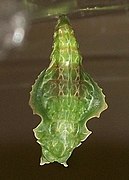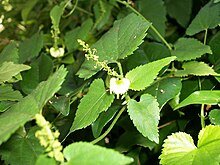Eurytela dryope
| Eurytela dryope | ||||||||||||
|---|---|---|---|---|---|---|---|---|---|---|---|---|

Eurytela dryope |
||||||||||||
| Systematics | ||||||||||||
|
||||||||||||
| Scientific name | ||||||||||||
| Eurytela dryope | ||||||||||||
| ( Cramer , 1775) |
Eurytela Dryope is occurring in Africa Butterfly ( butterfly ) from the family of Nymphalidae (Nymphalidae).
features
butterfly
The wingspan of the moth is 40 to 50 millimeters for the males and 45 to 55 millimeters for the females. The species is not characterized by any sexual dimorphism . In both sexes, the base color on the upper sides of the wings is brown. Below the pointed apex of the forewings, a yellow band extends along the seam, which widens and continues on the hind wings. A dark brown wavy line runs directly on the hem. The undersides of the wings are marbled in various shades of yellow and brown.
Pre-imaginal stages
The egg has a whitish to greenish color, a hemispherical shape and shows fine thorns on the longitudinally ribbed surface.
The caterpillars appear in different colored morphs. So they vary from green to black individuals. The entire surface of the body is provided with branched thorns. There are two branched straight horns on the head.
The doll has an angular shape that ends in two points at the lower end. It is green or brown in color, has a rough surface and wide wing sheaths. It is attached to twigs, trunks or leaves as a falling doll with a webbing anchorage.
Distribution, subspecies and habitat
The distribution area of the species extends south of the Sahara across the African continent. In addition to the nominate form Eurytela dryope dryope , which is common in Sierra Leone , Cameroon and the north of Zaire , the following subspecies are also listed:
- Eurytela dryope angulata Aurivillius , 1898, in South Africa , Angola , southern Zaire, East Africa, and Ethiopia
- Eurytela dryope brittoni Gabriel , 1954, on the Arabian Peninsula
- Eurytela dryope lineata Aurivillius , 1898, in Madagascar
Eurytela dryope primarily inhabits dry, open forests and savannas . The altitude distribution ranges from sea level up to 1500 meters.
Way of life
The moths fly in several generations throughout the year. They are most numerous between November and June. They occasionally suckle on injured tree trunks or overripe fruit to absorb fluids, fructose and minerals. The eggs are laid one at a time on top of the leaves of the food plant. The caterpillars prefer to feed on the leaves of the plant species Tragia durbanensis ( synonym : Tragia glabrata ), which belong to the milkweed family (Euphorbiaceae ), as well as the miracle tree ( Ricinus communis ).
Individual evidence
- ^ A b c Steve Woodhall: Field Guide to Butterflies of South Africa , Cape Town, South Africa, Struik Publishers, 2005, ISBN 978-1-86872-724-7
- ↑ Description of the pre-imaginal stages
- ↑ Markku Savela: Tanaecia Butler, [1869] - distribution. In: Lepidoptera and some other life forms. Accessed February 13, 2019 .
Web links
- learnaboutbutterflies - Butterflies of Africa, Golden Piper
- abdb-africa - African Butterfly Database




